 |
|||||||||||||||
|
|||||||||||||||
 |
||
|
 |
||||||||||||
|
||||||||||||
 |
|||||||||||||||||||||||||||||||||||||||
|
|||||||||||||||||||||||||||||||||||||||
|

The Life of Pope John Paul:
Shepherd of Souls or
Antiquated Authoritarian?
By Tim Graham,
Director of Media Analysis
April 14, 2005
Page 2 of 2
|
III. Liberals vs. John Paul Reporters who see themselves as advocates for democracy and modernity found Pope John Paul lacking in both during his tenure, insisting that he needed to stop his fuddy-duddy conservative opposition to the sexual revolution, look at the public opinion polls and get with the times, especially to keep parishioners inside the Catholic churches of America. An April 5 AP story remembering Pope John Paul’s popularity with young people quoted Robert Drinan, the former congressman priest, declaring his death was “like a grandfather dying and one girl reminded me that her grandfather never approved of her jeans.” Reporters have perpetually portrayed the American Catholic Church as the randy grandchild rolling their eyes at the out-of-touch Polish grandpa. In an October 2, 1995 Style section story in the Washington Post, writer Henry Allen revealed the media attitude bluntly: “There are 60 million Catholics in America, and for many of them he also speaks with the voice of a conservative crank when he stonewalls on abortion, birth control, married priests, women priests and so on.” Reporters also resented the Pope’s resistance to international bureaucracies trying to spread the culture of social liberalism.
■ Newsweek’s Eleanor Clift, on the May 11, 1994 McLaughlin Group, displayed the media’s desire for utter rejection of the conservative Vatican influence on the global culture in the buildup to the UN Population Conference in Cairo: “I’m rooting for a return to the Italian Popes, because in Italy they absolutely flaunt the Vatican and they may act as an effort to bring the Church into alignment with modern life. The Church is virtually alone in its position on abortion as we approach this population conference.”
■ ABC repeatedly demonstrated a hostility to religious objections to the UN consensus. On October 7, 1994, Peter Jennings announced: “In Cairo, the Pope’s representatives are causing tempers to flare at the World Population Conference as the Vatican holds to its uncompromising position on abortion. ABC’s Jim Bittermann reports from there that what on the surface appears to be a debate over a few words has badly distracted from the conference’s overall mission.” Bitterman reported the spin from the Planned Parenthood side: “Vatican representatives at the population conference were today being cast in the role of spoiler, their stubborn style angering fellow delegates....And delegates weren’t the only ones frustrated. Thousands of activists, who came here to push causes from the environment to women’s rights, have been ignored as the representatives from 182 nations spend their time and energy debating the abortion issue.” ■ On October 8, 1995, at the same time reporters were celebrating the papal visit’s potential to hurt the Gingrich Republicans in Congress, Today co-host Giselle Fernandez asked American papal envoy Mary Ann Glendon: “The Pope’s stands on issues such as, for instance, abortion, popularity control, birth control -- is he aware that American Catholic women, the majority, have different views than he does on these matters?” NBC thought the Pope should be more worried about his “popularity control” — yes, Fernandez actually said that — than about conserving a traditional sexual ethic. ■ NBC’s David Gregory displayed the media’s rhetorical tricks on the July 23, 2001 NBC Nightly News. The Pope’s stand against embryo-destroying stem cell research was not a problem for liberals, but for the conservative president. “In front of reporters, the Pontiff called the creation of embryos for research a symbol of a, quote, ‘tragic coarsening of consciences’.... Determining the right thing to do on stem cell research has not been so easy for Mr. Bush, and today the Pope only made it harder.” The media’s rigidity on the separation of church and state grew much firmer when the Pope disagreed with the Clinton administration or the United Nations or other liberal activists. Suddenly the “wall of separation” was breached, and papal opinions were no longer welcomed.
IV. “Catholics” vs. Catholicism
■ On May 4, 1990, NBC Nightly News anchor Tom Brokaw covered the Pope’s trip to Mexico, “a country where there’s a huge population problem. Many people say that problem is magnified by the Church’s opposition to birth control.” Reporter George Lewis found anonymous “experts” to disparage the Church: “Family planning experts say that ignorance and superstition play a big role in Mexico’s population crisis...they also say the Catholic Church has to share the blame.” ■ When Pope John Paul came to Denver in 1993 for World Youth Day, the most biased TV story from the trip came on the CBS show Sunday Morning on August 8. Reporter Jerry Bowen presented 13 soundbites of papal critics and dissenters, compared to just two from Denver Archbishop Francis Stafford. Critics included a nun, Sister Mary Luke, who said the church must have female priests and rid the Church of “this kind of patriarchy”; a divorced mom, Leanna Day (“It’s real strict and real rigid, and we can’t, we don’t live a real strict and rigid life”); Day’s liberal priest, Father John Burton (“The Church either changes with the world, or it’s left as a museum piece”) and Jim Beeten, a former seminarian who quit because he refused to remain celibate. Bowen defended his story to the MRC’s MediaWatch at the time as full of “very devout Catholics.” This was typical of TV coverage of the trip: an MRC count of 14 network stories on the papal visit found 57 soundbites criticized church teaching, while only 27 defended it. ■ A week later on the same program, Jerry Bowen concluded: “There are some who say he would have been more comfortable in the 5th century, but some theologians say that really, some of the 5th century Popes were more progressive than John Paul II.” When MediaWatch asked whether Bowen had studied the 5th century Popes or what theologians said to him, he insisted it was a joke: “These are comments that are made in less of a scholarly vein...I think it’s a light-hearted observation.” He added: “I didn’t think of it as being anti-John Paul or anti-Pope.” ■ On January 22, 1995, the CBS show 60 Minutes devoted an entire segment to promoting the left-wing group Call To Action, beginning with the “many Catholics” line: “Among the things they challenge is the Pope’s position on birth control, on women becoming priests, and on priests being able to marry....There’s no denying that for many American Catholics, those teachings have lost their appeal.” Father Mike Flager denounced the Church as “spiritually bankrupt” and said the traditional Church has “a love it or leave it, you know, it’s that crazy patriotism philosophy.” Edwina Gately “was described as a devout Catholic with the tongue of a pagan tart.” Gately replied with a smile: “Well, I’m OK with the ‘pagan tart,’ it’s the ‘devout Catholic’ that worries me.” Wallace reminded her she once said “the Vatican is the only tyranny left in the world today.” But Wallace insisted his subjects were “hardly wild-eyed radicals, these people from Call to Action. They’re sober church workers, nuns and priests, and just plain concerned Catholics... their ideals formed in the heady age of change back in the ‘60s.” Wallace’s report included 25 soundbites from the “dissidents” without broadcasting a single voice in favor of traditional Catholicism. Wallace later conceded to the Catholic newspaper Our Sunday Visitor that “interviews with Harvard law professor Mary Ann Glendon and George Weigel of the Ethics and Public Policy Center, prominent lay Catholics who support Church teaching, were not used because producers felt the material was too dissimilar to work with footage from the Call to Action conference.” They were also “too dissimilar” with CBS thinking. ■ Several magazine clips aptly illustrate the media’s liberal “reform” impulse from outside the world of religion. In a June 18, 1999 feature titled “A Closer Look,” Time magazine’s Web site revisited a favorite pejorative ‘R’ word as related to the Pope. The subheadline read, “As the millennium ends, the era of John Paul II draws to a close. And soon the Vatican must decide how much of the Polish Pope’s revolution — and his rigidity — it wants to keep.”
Like many other reporters, Pellegrini could not understand why the Pope wouldn’t run his church like a focus group: “It is a Catholicism that stands, on the ideological spectrum, far to the right of what many of even its devotees would like it to be, and thanks to John Paul’s appointees it is not likely to budge. In answer to the forces of liberalism, John Paul II has stacked the deck.” ■ In her Web-exclusive column on March 29, 2002, Newsweek’s Eleanor Clift perfectly distilled how the media see the world through secular and political eyes. Clift began: “Congress has made some changes, and maybe the church can, too.” In what may be a first for liberals, Clift suggested an end to a centralized bureaucracy: “The papacy as we know it, is a 19th-century convention. The idea that in an age of e-mail and fax, and the ability to whisk around the globe in jets, everybody kowtows to a central figure seems quaint.” Clift also banged the drum for an end to priestly celibacy: “The priesthood attracts sexually conflicted men, and the church will have to face up to that as a potentially criminal matter, not as a way to perpetuate an outdated custom of celibacy.”
■ On the October 12, 2003 This Week with George Stephanopoulos, the host questioned liberal Catholic priest and magazine editor Father Thomas Reese from the left: “Many of the Pope’s critics have a hard time reconciling his outspoken championing of human rights, of human dignity with what they see as his somewhat authoritarian, antiquated view of women and sexuality.” He also asked: “The Pope has held the line on women clergy and this has made many of his critics say he simply doesn’t get it when it comes to women.” ABC’s Cokie Roberts then elaborated on the liberal theme: “You can feel very left out when you approach an institution that is completely male-dominated and hierarchical. It’s bad enough in this country, where at least we have women on the altar doing readings and girls on the altar as servers. When you actually go the Vatican in Rome, at St. Peter’s there’s not a woman in sight around the altar, there’s not a lay person in sight, and there’s a sense of alienation, there’s no question about that. You really have to say to yourself, ‘this is my church despite that.’” ABC asked only five people to offer opinions on John Paul’s legacy: Reese, Roberts, former Vatican Ambassador and Congresswoman Lindy Boggs (Cokie’s mother), Cardinal Oscar Rodriguez of Honduras, and, for non-Catholics, Mikhail Gorbachev. ■ CBS reporter Allen Pizzey summed up the occasion on the Evening News of October 16, 2003 with the usual emphasis on the many “flaws” (read: conservatism) of the Pope: “He helped end communism, reached out to Muslims by entering a mosque, sought reconciliation with the Jews by praying at the Wailing Wall....but his legacy is not without flaws. His staunch refusal to ordain women as priests and rigorous rejection of birth control, abortion and homosexuality, have alienated many.” Notice that in the media argot, cafeteria Catholics never “alienate” other members of the Church, and are not to be described as “divisive.” Only conservatism alienates and divides.
V. Conclusion In all the attention the media will pay to the selection of a new Pope, and entering into an era evaluating what John Paul’s long and influential pontificate means in Church history, journalists should keep in mind that their coverage of the Church should be designed to present a fair and accurate picture of the proceedings without putting their thumb on the scale in an attempt to invent a Catholic Church more in tune with secular journalists. The secular media can clearly play a powerful role in reforming human corruption in religious institutions, as all the coverage of the nightmare of clerical sex abuse in the Catholic church has shown. Papal historian George Weigel has cautioned those who find too much joyful aggression in the coverage of corrupt priests that despite the major media’s secularism, their drive to expose and drive out corruption in the priesthood looks a lot like God’s work. Pope John Paul told the faithful that in the documents of the Second Vatican Council, the church teaches that one of its major goals in the world is to evangelize people to the gospel message of Jesus, to spread the good news of a savior who cleanses the sins of all who believe in Him. Church leaders hope that major media coverage can in some way bring readers and viewers a better understanding or deeper commitment to Catholicism. This often seems to be in conflict with what the secular media wants. It seems to find Catholic and evangelical Christian evangelization and conversion not in their interests, a force inimical to “progressive” social and political goals. Its advocacy in favor of the “many Catholics” who share their beliefs can resemble their usual political coverage, trying to convince the loosely committed voter, or the loosely committed religious believer, that all good sense and all polling majorities inevitably will land on the side of the liberal worldview, that “tolerance” is the wave of the future, and “absolutism” belongs in a previous century. The media all too often scratch that inevitable itch to not just report the first draft of history, but to push, prod, and persuade to create a history of their own making, to their own liking. The audience cannot merely be informed. It must be led to accept the media’s daily dogma.
The Media Research Center For an interview with an MRC Spokesman, please contact Tim Scheiderer at (703) 683-5004
Home | News Division
| Bozell Columns | CyberAlerts |
||||





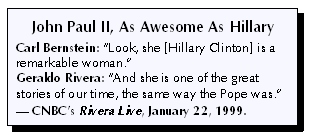 ■ On the November 6, 1989 edition of ABC’s
Good Morning America, reporter Kathleen DeLaski told viewers: “The bishops are expected to adopt a more conservative policy on AIDS prevention this week, one more in line with the Vatican, but less popular with many American Catholics. Some showed their displeasure outside yesterday’s Mass that opened the conference.” DeLaski then showed these alleged “Catholics” screaming “Racist, sexist, anti-gay! Catholic bigots, go away!” DeLaski added: “Many gay Catholics feel the proposal is irresponsible.”
■ On the November 6, 1989 edition of ABC’s
Good Morning America, reporter Kathleen DeLaski told viewers: “The bishops are expected to adopt a more conservative policy on AIDS prevention this week, one more in line with the Vatican, but less popular with many American Catholics. Some showed their displeasure outside yesterday’s Mass that opened the conference.” DeLaski then showed these alleged “Catholics” screaming “Racist, sexist, anti-gay! Catholic bigots, go away!” DeLaski added: “Many gay Catholics feel the proposal is irresponsible.”
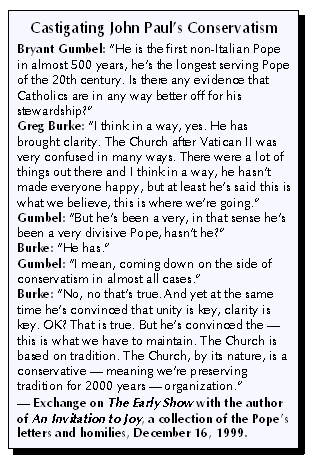 ■ Pope John Paul drew disdain from the networks for “distracting” the Cairo conference with his anti-abortion stance. Citing a “nasty fight” between President Clinton and the Pope, CBS reporter Martha Teichner remarked on September 3, 1994: “The security in effect for the UN Population Conference in Cairo is the kind used to prevent aircraft hijackings. But so far, the only hijacking taking place is of the agenda.”
■ Pope John Paul drew disdain from the networks for “distracting” the Cairo conference with his anti-abortion stance. Citing a “nasty fight” between President Clinton and the Pope, CBS reporter Martha Teichner remarked on September 3, 1994: “The security in effect for the UN Population Conference in Cairo is the kind used to prevent aircraft hijackings. But so far, the only hijacking taking place is of the agenda.”
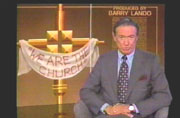 When discussing “reform” of the Catholic Church in the last quarter-century, the secular, politically minded liberal media establishment often demanded religion by ballot, with no room for sacred traditions, and no awe for an “authoritarian” God. TV coverage suggested the public should only hear the views of the Church’s attackers; reporters had little use for traditionalists. It’s one thing to describe a church conflict with a fair and balanced approach. But the media glorified and enlarged the influence of dissenters, constantly identifying and quoting what they called the “many Catholics” who agreed with their worldview.
When discussing “reform” of the Catholic Church in the last quarter-century, the secular, politically minded liberal media establishment often demanded religion by ballot, with no room for sacred traditions, and no awe for an “authoritarian” God. TV coverage suggested the public should only hear the views of the Church’s attackers; reporters had little use for traditionalists. It’s one thing to describe a church conflict with a fair and balanced approach. But the media glorified and enlarged the influence of dissenters, constantly identifying and quoting what they called the “many Catholics” who agreed with their worldview.
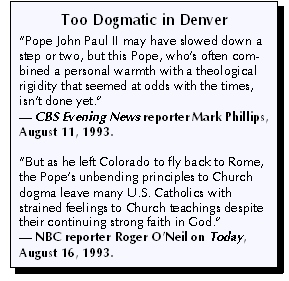 Reporter Frank Pellegrini complained: “The enormous charisma of the man has made zealots of the converted and converts of the heathen, but John Paul II has brooked no heretics.... it is impossible to call John Paul II anything other than a conservative. He does not take to new currents in Catholicism, and has displayed a ready pen for excommunication. He is stoutly against birth control, abortions and female priests, and has similarly held the line on remarriage after divorce, annulments and celibacy in the priesthood....When the Pope comes to the [United] States, nuns argue with him, liberal Catholics tug at their collars nervously, and liberated women grouse.”
Reporter Frank Pellegrini complained: “The enormous charisma of the man has made zealots of the converted and converts of the heathen, but John Paul II has brooked no heretics.... it is impossible to call John Paul II anything other than a conservative. He does not take to new currents in Catholicism, and has displayed a ready pen for excommunication. He is stoutly against birth control, abortions and female priests, and has similarly held the line on remarriage after divorce, annulments and celibacy in the priesthood....When the Pope comes to the [United] States, nuns argue with him, liberal Catholics tug at their collars nervously, and liberated women grouse.”
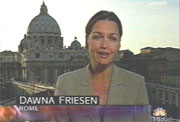 ■ On the 25th anniversary of Pope John Paul’s reign came in October of 2003, the liberal line – “many Catholics” vs. the intransigent Pope – emerged again. On the October 12
NBC Nightly News, reporter Dawna Friesen emphasized: “For some, the celebrations will be bittersweet. The Pope’s conservative views on abortion, contraception, divorce, woman priests and homosexuality have alienated many Catholics, as did the sex abuse scandals involving priests.” But Friesen ended with a Wisconsin woman, Mary Sadarno, who said being in the Pope’s presence reaffirmed her faith.
■ On the 25th anniversary of Pope John Paul’s reign came in October of 2003, the liberal line – “many Catholics” vs. the intransigent Pope – emerged again. On the October 12
NBC Nightly News, reporter Dawna Friesen emphasized: “For some, the celebrations will be bittersweet. The Pope’s conservative views on abortion, contraception, divorce, woman priests and homosexuality have alienated many Catholics, as did the sex abuse scandals involving priests.” But Friesen ended with a Wisconsin woman, Mary Sadarno, who said being in the Pope’s presence reaffirmed her faith.
